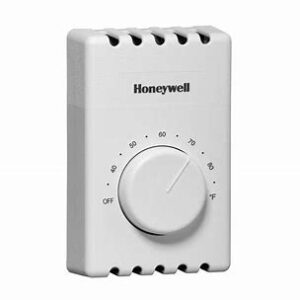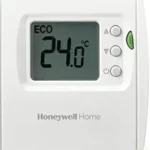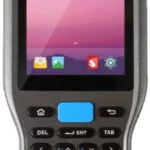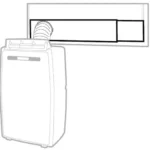
CT410B1017/E1
CT410B1023/E
CT410A1019/E1
Installation Instructions pdf]: T410A,B Line Voltage Electric Heat Thermostats
Instrucciones De Instalación [pdf]: Termostatos de calefacción eléctrica de voltaje de línea T410A, B
What is a heat pump?
A heat pump uses the outdoor unit for both heating and cooling. Often the heat pump also has some sort of backup or auxiliary heat for when it is cold outside. The backup or auxiliary heat could be electric heat strips or a fossil fuel furnace. Thermostats that control heat pumps with backup or auxiliary heat typically have an Em Heat (Emergency heat) position. When the system switch is moved to the Em Ht. position, the auxiliary heat is activated on a call for heat. The compressor is disabled. If replacing a thermostat on a heat pump system, verify your thermostat is compatible.
What is the difference between “Aux Ht” and “Em Ht”?
Aux Ht or Auxiliary heat is the backup heat that turns on to help the compressor for first stage maintain your temperature setting. You know if the auxiliary heat is running when you see “Aux Heat On” in the thermostat’s display. During this time both your Auxiliary heat and your compressor may be on at the same time. The thermostat will only run the Emergency Heat when the thermostat’s system switch is moved to the Em Ht position. When the thermostat is in this position the compressor does not run, only the Emergency heat runs. It is common that the Emergency heat and auxiliary or backup heat is the same source of heat (electric heat strips or fossil fuel).
What is a resistive load?
A resistive load is typically an electric baseboard heater. In resistive loads, the amperage remains the same throughout the call for heat. Inductive loads are typically seen in a motor load. The motor will pull a greater amount of amperage to start and then will drop significantly once the motor is running. Inductive loads require a thermostat specifically designed for inductive loads. The higher the temperature, lower the resistance
Why is my thermostat set to heating, but I feel cool or mild air and not heat? (Or why is my thermostat set to Cooling but I feel heat or mild air and not cooling?)
Check your jumper selector switch. If you have a wire in the RC terminal and no wire in the R terminal, move the RC wire to the R terminal and move the jumper selector switch up to the “1 Wire” position. If you have a wire in the R terminal and a wire in the Rc terminal, the jumper selector switch must be in the “2 Wire” position.
Check your wiring. If you have a heat pump, you will not use a wire in the W terminal. Move the W wire to the W2 or Aux terminal. (W controls your first stage of heating for Gas/Oil/Electric systems. O/B and Y control your first stage heating for heat pump systems. Backup heat sources must be connected to the W2, Aux, or E terminal for proper functionality.)
Check your configuration. Most commonly, O/B is energized in Cooling (O on cool). For Rheem or Ruud brand heat pumps, the O/B must energize on heating (B on Heat).
What is a cycle rate?
Your thermostat is designed to control temperature to +/- 1 F, the cycle rate setting is one factory that helps the thermostat maintain your temperature setting. How often your heat turns on and off depends on may factors including the type of heating system you have as well as how much your system needs to run to maintain your temperature setting (in other words, how cool or cold it is outside). A typical forced air system will cycle about five times in an hour, this is normal. A typical hot water system would cycle less then that. Every heating system type will deliver heat to the house at a slightly different rate. Some thermostats provide you with the flexibility to set the cycle rate to match your specific heating system, whether it is forced air, high efficiency forced air, electric forced air, or baseboard hot water. Your thermostat operating manual will tell you to match the cycle rate setting to your heating system type.
Manual 4-wire Premium Baseboard Thermostat
| Thermostat Type | Mechanical, Non programmable |
| Color | White |
| For Use With | Radiant cable, electric baseboard, and resistive-rated fan forced heaters |
| Program Modes | Manual / Not Programmed |
| Product Height | 4.5 in |
| Product Length | 2.75 in |
| Product Width | 1.5 in |
| Warranty | 1 Year |
| Energy Star Certified | No |
| Stages | 1 Heat |



